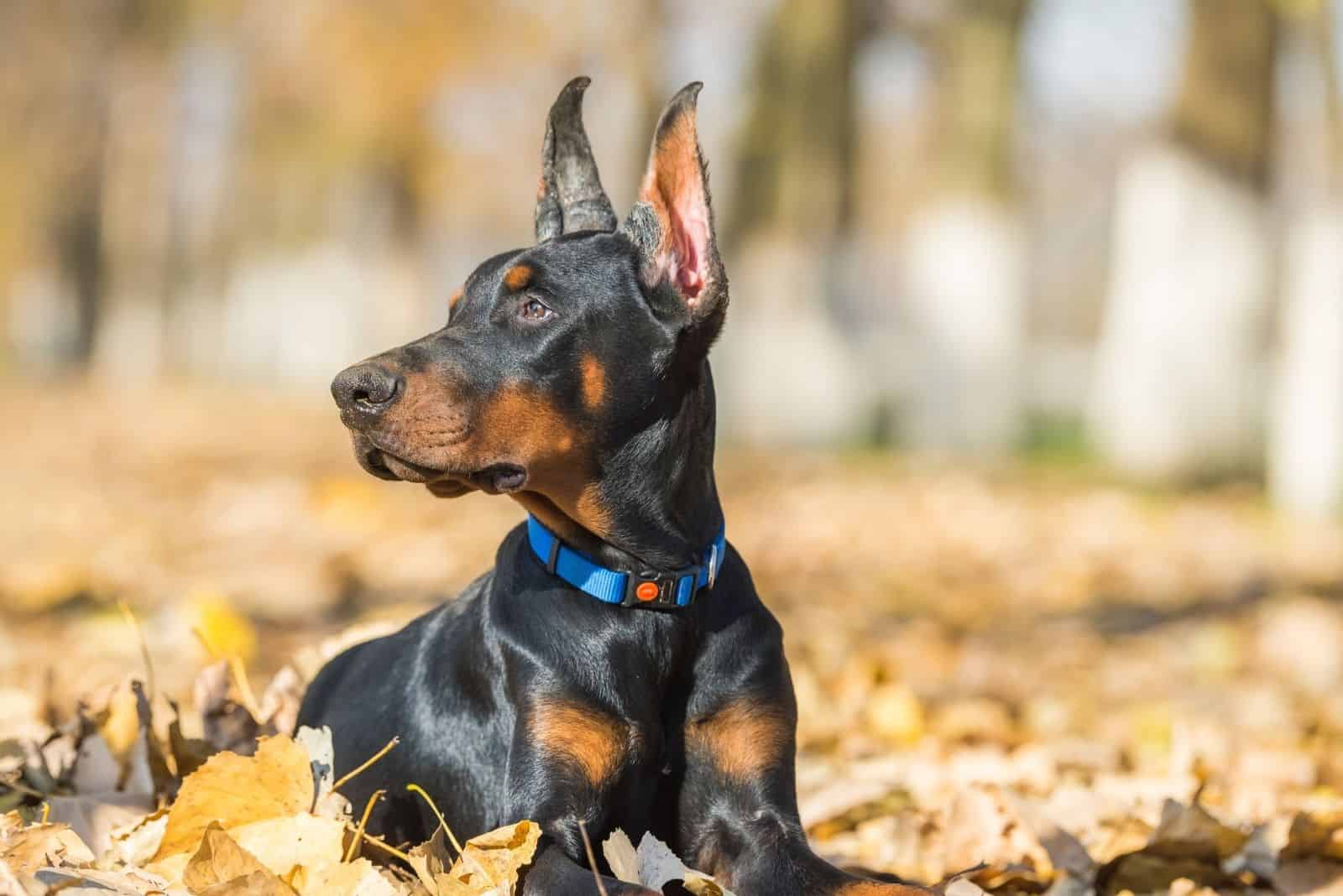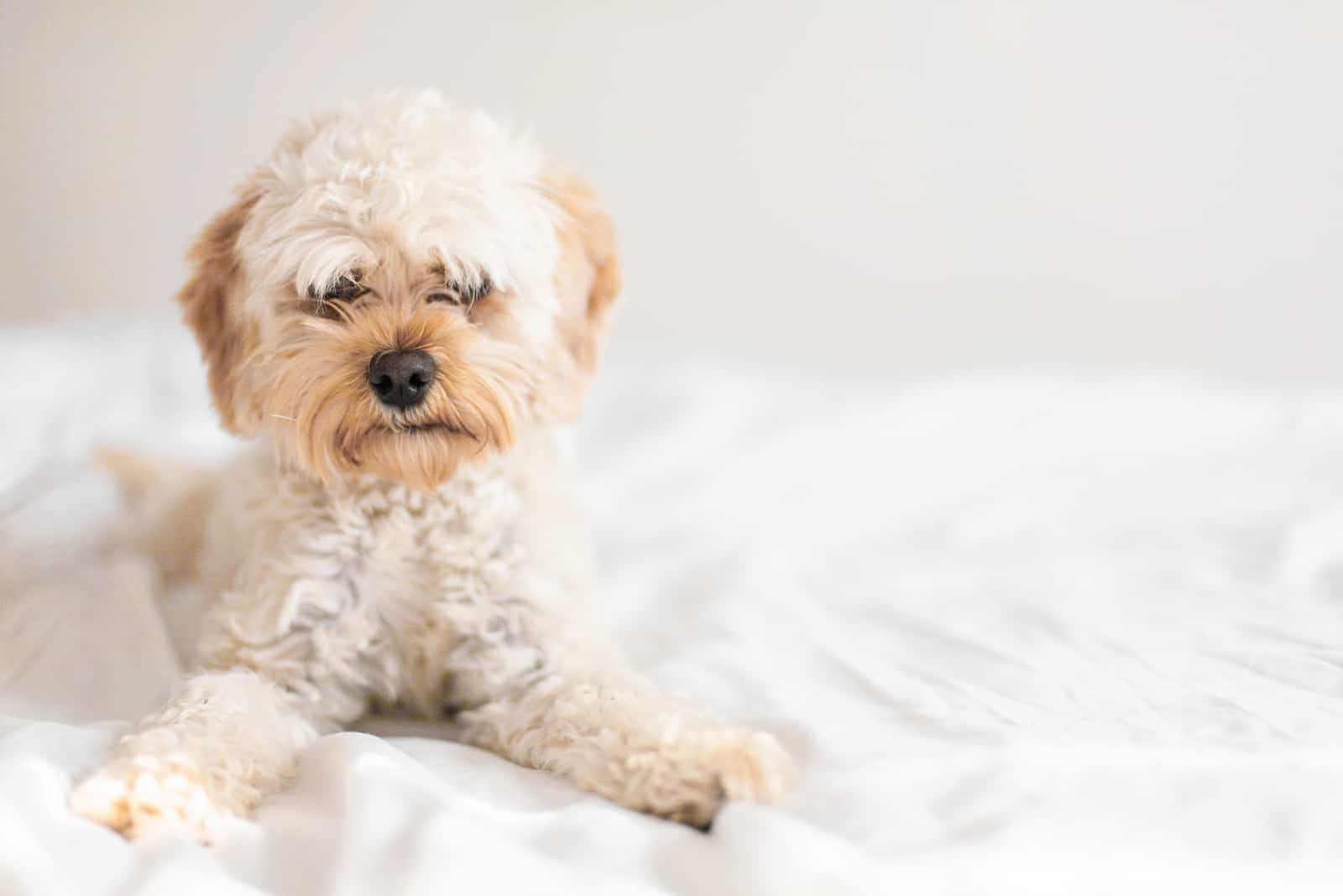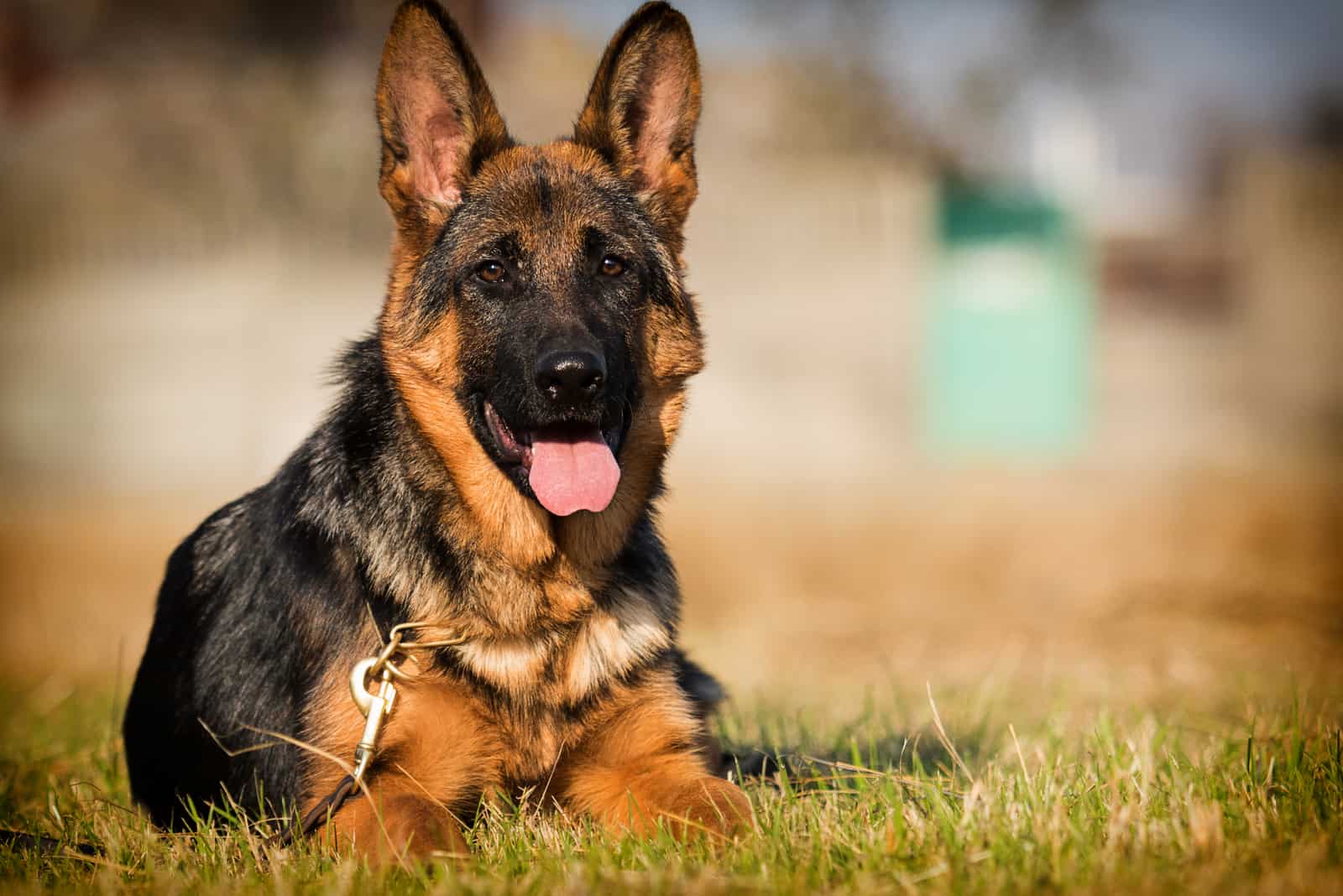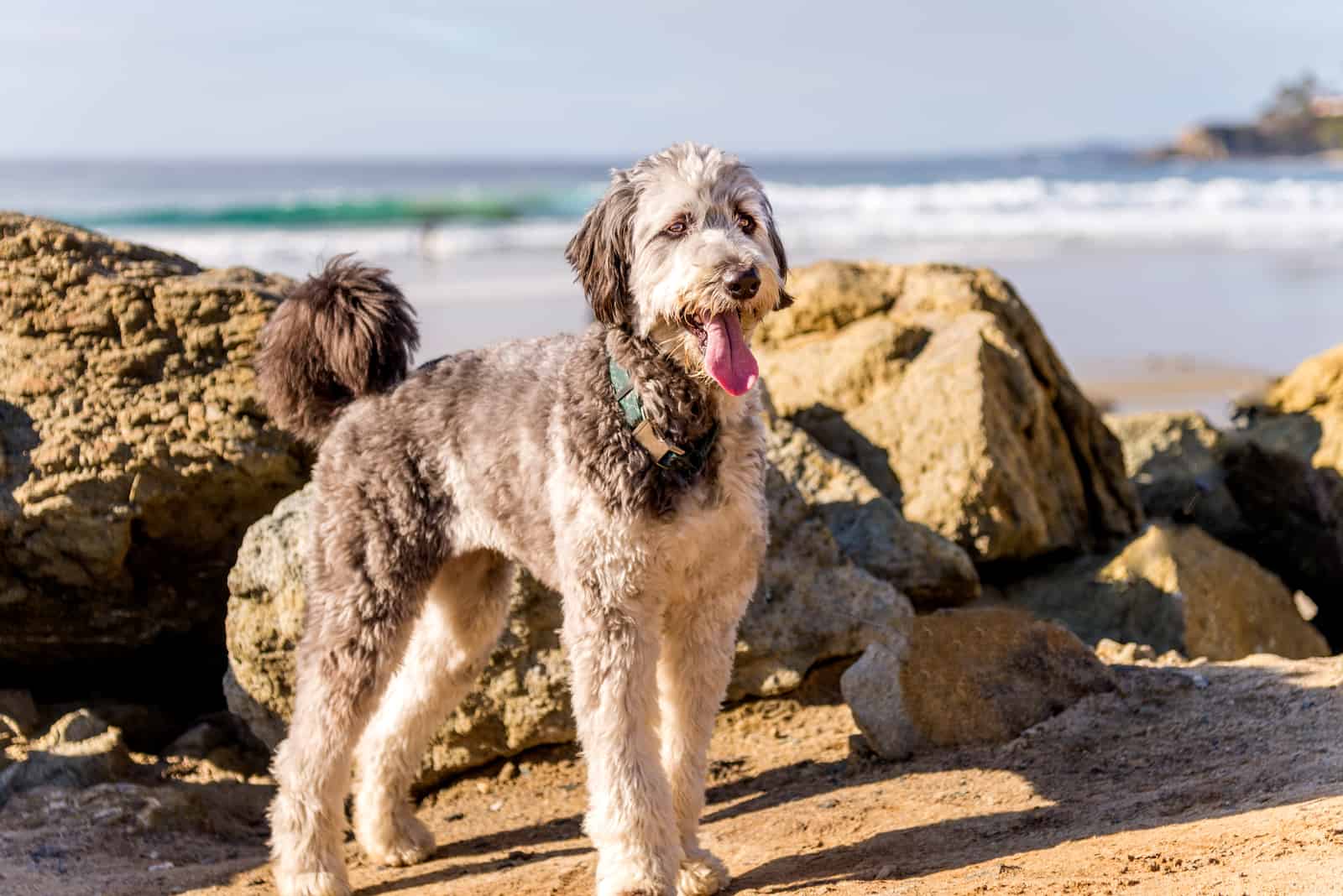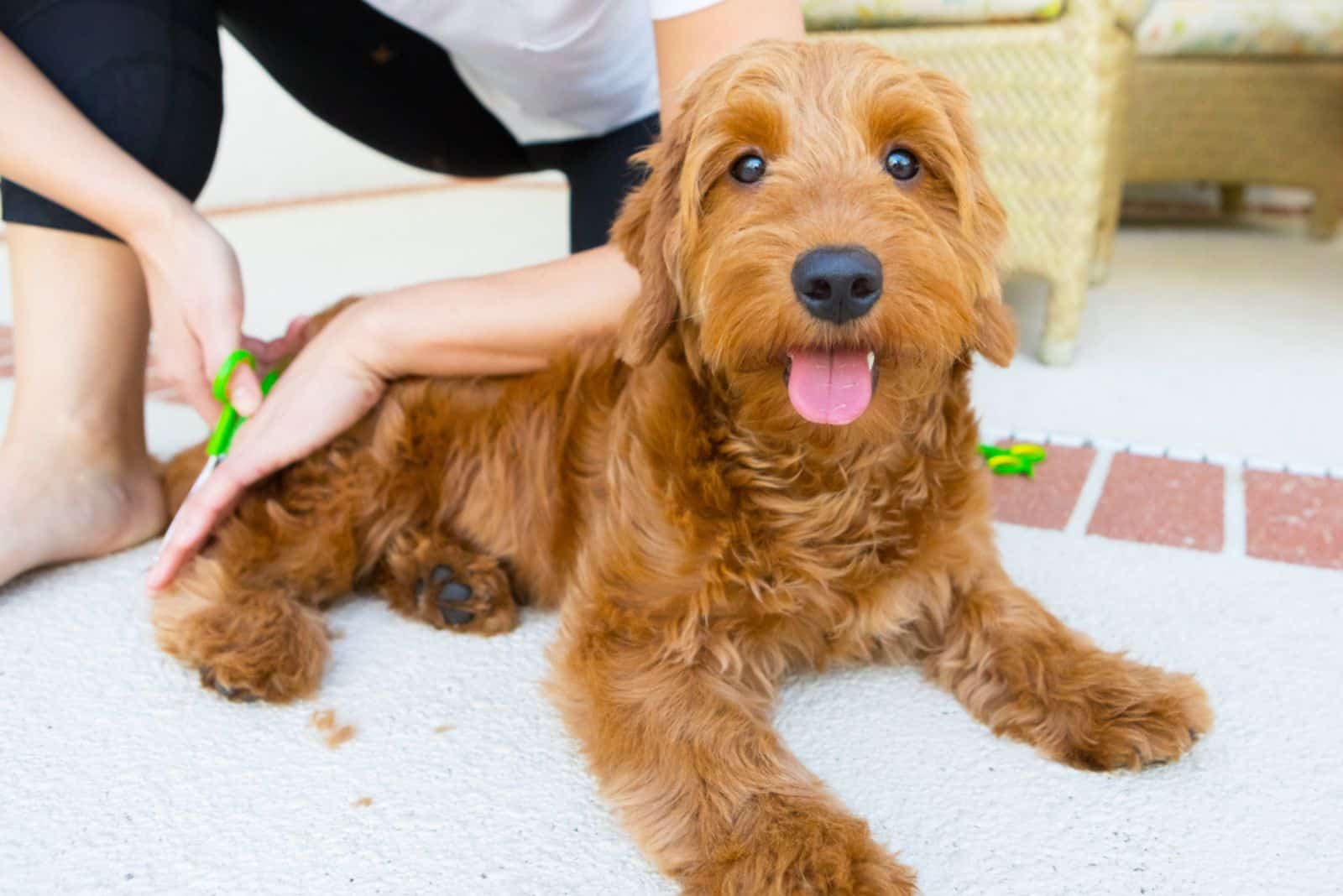So, you want to know the answer to the question, Are Bernedoodles hypoallergenic?
We promised you an honest answer, so here it is: Yes, most Bernedoodle dogs are considered hypoallergenic.
However, as there’s a lot of confusion surrounding this issue, we should dig deeper and explain our answer.
We’ll begin our guide with a quick overview of the Bernedoodle before exploring the topic of dog allergies and addressing some of those misunderstandings.
What Are Bernedoodles?

To make a Bernedoodle, you take a purebred Poodle and a Bernese Mountain Dog and put them together to produce puppies.
Now, this might sound simple enough, but it should always be left to breeders with the knowledge and experience to carry out the job correctly. It takes years of experience, along with patience, money, and effort, to breed dogs correctly and ethically.
This mixed-breed dog hasn’t been around for long, arriving on the scene in 2003. Unlike the parent breeds, they were created to be companions rather than working dogs, combining the Berner’s steadfast loyalty and strength with the Poodle’s goofy playfulness and sharp intelligence.
They are among the best family dogs you can get and are often recommended for first-time dog owners.
These hybrid dogs come in three sizes:
• Standard Bernedoodle 23 to 29 inches and 70 to 90 pounds. These are a cross between the standard Poodle and Berner.
• Miniature Bernedoodle 18 to 22 inches and 24 to 29 pounds. A crossbreed of the Miniature Poodle and Berner.
• Tiny Bernedoodle 12 to 17 inches and 10 to 24 pounds. A mix of the Toy Poodle and Bernese Mountain Dog.
These designer dogs were created to overcome three major problems with the Bernese Mountain Dog: shedding, drooling, and lifespan.
As wonderful as the Berner is, it doesn’t live very long. This unfortunate pooch has a lifespan of between 6 and 8 years.
They’re also big droolers! Seriously, they leave pools of saliva all over, as any Berner owner will tell you. On top of this, they shed a lot. And we mean a lot. They’ll drop hair throughout the year and then profusely in shedding seasons.
To overcome these issues, breeders created the Bernedoodle. This unique pooch combines the best of both breeds to produce one very affectionate, intelligent, loyal, and friendly dog that doesn’t drool, has a long lifespan, and rarely sheds!
And this last fact is connected with our question, Are Bernedoodles hypoallergenic?
Continue reading to find out why.
Why Are People Allergic To Dogs?
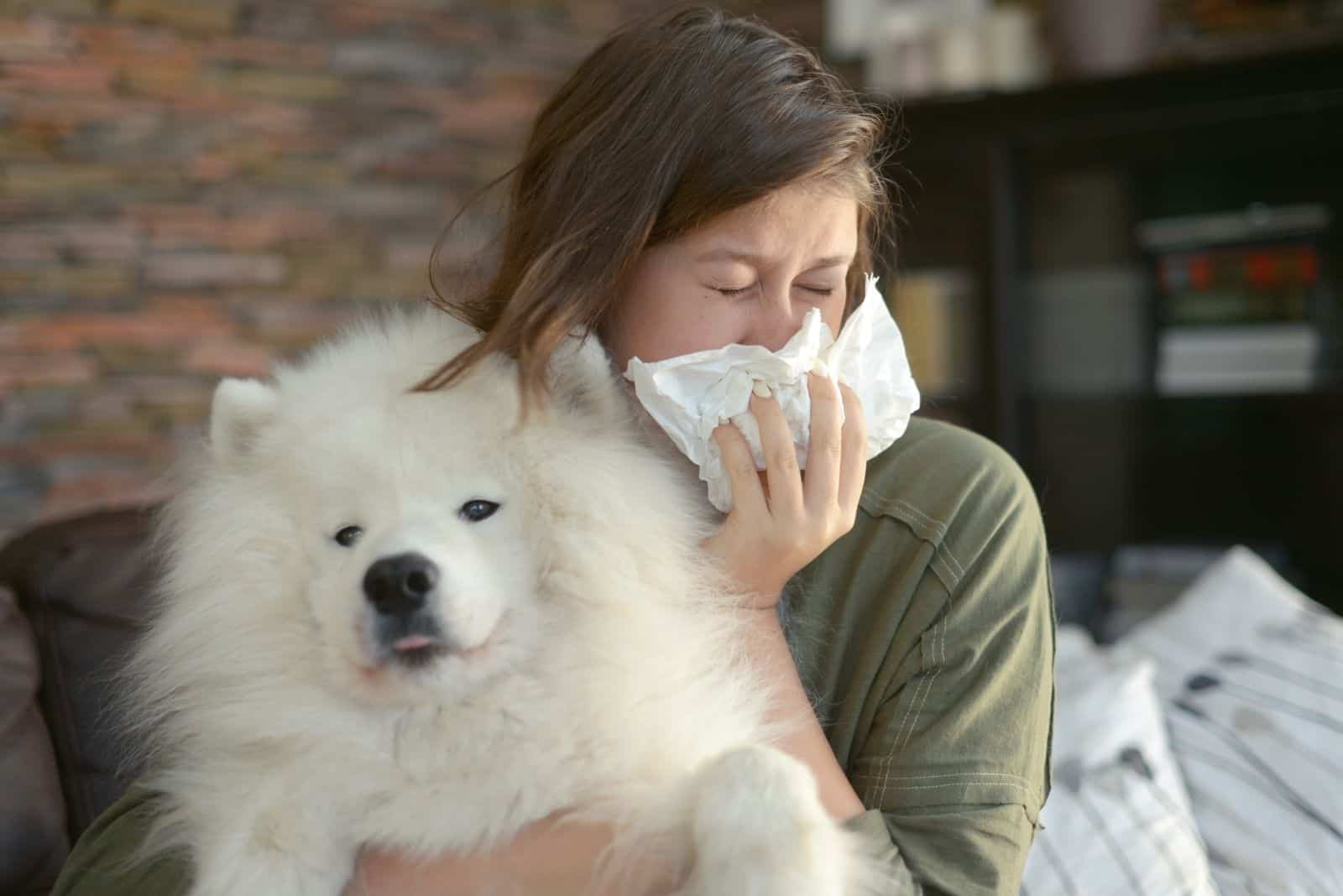
To understand why Bernedoodles might be a good choice for allergy sufferers, we need to know what triggers pet allergies and be clear as to what the word hypoallergenic means.
First, let’s examine why some of us have allergic reactions to our pets.
While the human body is a fantastic machine, it has its flaws. Our immune systems keep us safe 24 hours a day, fending off billions of bacteria that are trying to gain a foothold in or on our bodies.
If only we knew just how hard our immune system worked, we’d probably treat it better.
Even so, it sometimes works a little too hard.
Our furry friends produce dander, which is similar to dandruff. These dry skin flakes stick to dog hair or float freely in the room. Eventually, these tiny particles enter your nose, eyes, and mouth, and that’s when the ‘fun’ begins!
Our immune system sometimes identifies proteins in the dander as a foreign invader, so it goes into battle against them. A hormone called histamine is produced, flooding parts of the body to repel the ‘invader’ and repair any damage.
We start sneezing, our eyes itch, and we may get a rash. In severe cases, we may have difficulty breathing or feel our throat swelling up. This is a terrifying and distressing experience, which is why pet allergies are no joke.
The same proteins that cause the problem are found in dog saliva (and urine and feces), so if your dog licks you, then you’re more likely to encounter these allergens. Also, when a dog licks its coat, the saliva dries on the hair, which probably has dander stuck to it already!
So, there’s an increased risk that you’ll come into contact with the proteins one way or another.
It’s estimated that between 15% and 30% of all Americans have a pet allergy, and allergic reactions to dogs are of more concern because they tend to be more severe.
It’s no owner that people are asking, Are Bernedoodles hypoallergenic? Dog lovers everywhere don’t want to miss out on the joy of having a pooch in their home but are worried about how this will affect them or their loved ones if they have allergies.
What Does ‘Hypoallergenic’ Mean?
This word is the cause of much confusion and misunderstanding. Even the most well-meaning people make claims and suggestions based on a false understanding of what it actually means.
This includes major kennel clubs, vets, and breed enthusiasts.
For example, you’ll see phrases like ‘completely hypoallergenic,’ ‘truly hypoallergenic,’ and ‘100% hypoallergenic’. You’ll even come across people that say that hypoallergenic dogs don’t exist!
Once again, this is untrue and is based on a complete misunderstanding of the term.
Saying things like, ‘no dog is 100% hypoallergenic’ is absolute nonsense. What they really mean is, ‘no dog is 100% allergy free.’ It’s statements like this from people that are supposed to be experts that prolong the confusion.
So, let’s try and explain this simply: you can have hypoallergenic band-aids, earrings, food, cosmetics, soap, bedding, and so on. What do these have in common? They are all designed to be less likely to induce an allergic reaction.
Did you notice that phrase, less likely? It doesn’t mean you definitely won’t have a reaction. It means that steps have been taken to reduce the chances of an allergic reaction taking place.
This means that hypoallergenic dogs do exist. They’re a great choice for people with mild pet allergies, as they have special qualities that cause them to produce fewer allergens that will trigger a reaction. However, it depends on each individual dog and the severity of your allergy.
These qualities can’t be measured, so you categorically cannot classify a dog as 100% hypoallergenic or completely hypoallergenic. Also, anyone can suddenly develop an allergic reaction at any stage in their life.
We hope that’s cleared up the confusion? Now, back to the Bernedoodle!
What Makes Bernedoodles Hypoallergenic?
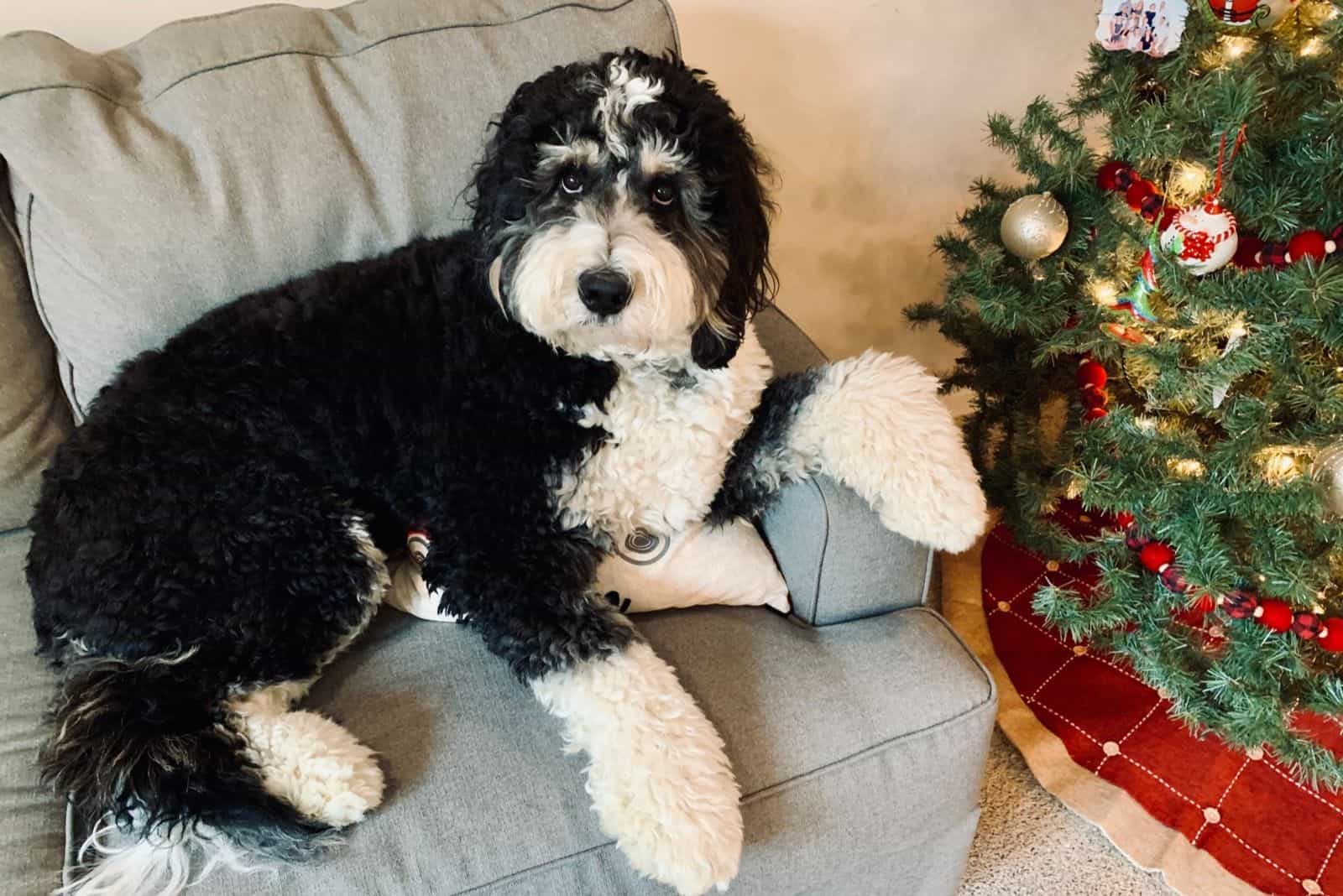
Having read our explanation above, you now know that the Bernedoodle crossbreed has specific qualities that make it allergy-friendly.
So, what are these qualities? Let’s find out!
• They don’t produce much dander. We know that dog dander is the biggest culprit. Any dog that produces less dander is good news for allergy sufferers.
• They have a low-shedding coat. There’s a persisting myth that dog hair causes allergies, but this is not true. It’s the dander and saliva on the hairs that are the problem! However, a low-shedding dog is good news for those with allergies, as it reduces the risk of contact with allergens.
• They do shed, but the dead hairs are trapped within the curls.
• They have a single coat. Dogs with double coats usually have a thick layer of fur under their topcoat. This fur dies and is replaced twice a year. Like Poodles, Bernedoodles don’t have this layer.
• They don’t clean themselves much. Some dogs always seem to be licking their coats. As we’ve seen, dog saliva carries the proteins that trigger allergies. Saliva sticks to the coat and is transferred to your hand when you pet your dog (or directly onto your face and lips if you hug and kiss them).
These are the main reasons for Bernedoodles being a good choice for allergy sufferers!
It’s important to be aware that there isn’t any such thing as a non-shedding dog, despite what you see elsewhere! All dogs shed to some degree, but the Poodle’s curly coat is low-shedding. The dead hairs become trapped in the curls and need to be brushed out.
Are Bernedoodle Puppies Hypoallergenic?

The best answer we can offer is, most probably. However, when puppies get to a certain age, they will shed their puppy fur as they grow their adult coat.
Also, it depends on the coat type they have inherited. If it’s the curly coat of the Poodle parent, then they’ll be allergy-friendly. However, if they take after the Bernese Mountain Dog, there is an increased chance of triggering allergies.
This is why we said most Bernedoodles are hypoallergenic right at the beginning!
Once your puppy has developed into an adult dog (somewhere between 18 months and two years), they won’t shed as much, so they’ll be less likely to trigger a reaction. However, the straight coat will always be more of a risk.
If you are concerned about allergies, speak with a reputable Bernedoodle breeder and ask them to set aside a pup with a curly coat.
Are F1 Bernedoodles Hypoallergenic?
First of all, you might wonder what an F1 Bernedoodle is!
Don’t worry; it’s pretty straightforward. The F1b is a 50/50 mix of the Poodle and Berner, meaning it’s a first-generation Bernedoodle.
When we asked our original question, ‘Are Bernedoodles hypoallergenic?’ most people would naturally assume that we were talking about these dogs. So, the answer is the same: yes, they are mostly hypoallergenic.
However, there are other generations, like the F1b Bernedoodle, F1bb, etc. We won’t go too deeply into this, except to say that the F1b is usually an F1 Poodle crossed with a purebred Berner, making Bernedoodle that’s only 25% Berner and 75% Poodle.
As you may have figured, this makes the F1b Bernedoodle more likely to inherit the Poodle coat, making it a great choice for pet allergy sufferers.
Are Mini Bernedoodles Hypoallergenic?
In a word, yes. Overall, they enjoy the same allergy-friendly status as their larger counterparts.
However, as with the large dog, it all depends on the individual person and how severe their allergy is.
Like the Standard Bernedoodle, an F1b Mini Bernedoodle will probably inherit the Poodle coat, thus reducing the risk of triggering allergies.
It’s worth mentioning again that any dog, whether it’s considered hypoallergenic or not, can induce an allergic reaction. People have been known to suddenly develop pet allergies after years of owning pets. It all comes down to the human immune system!
What Is The Most Hypoallergenic Dog?
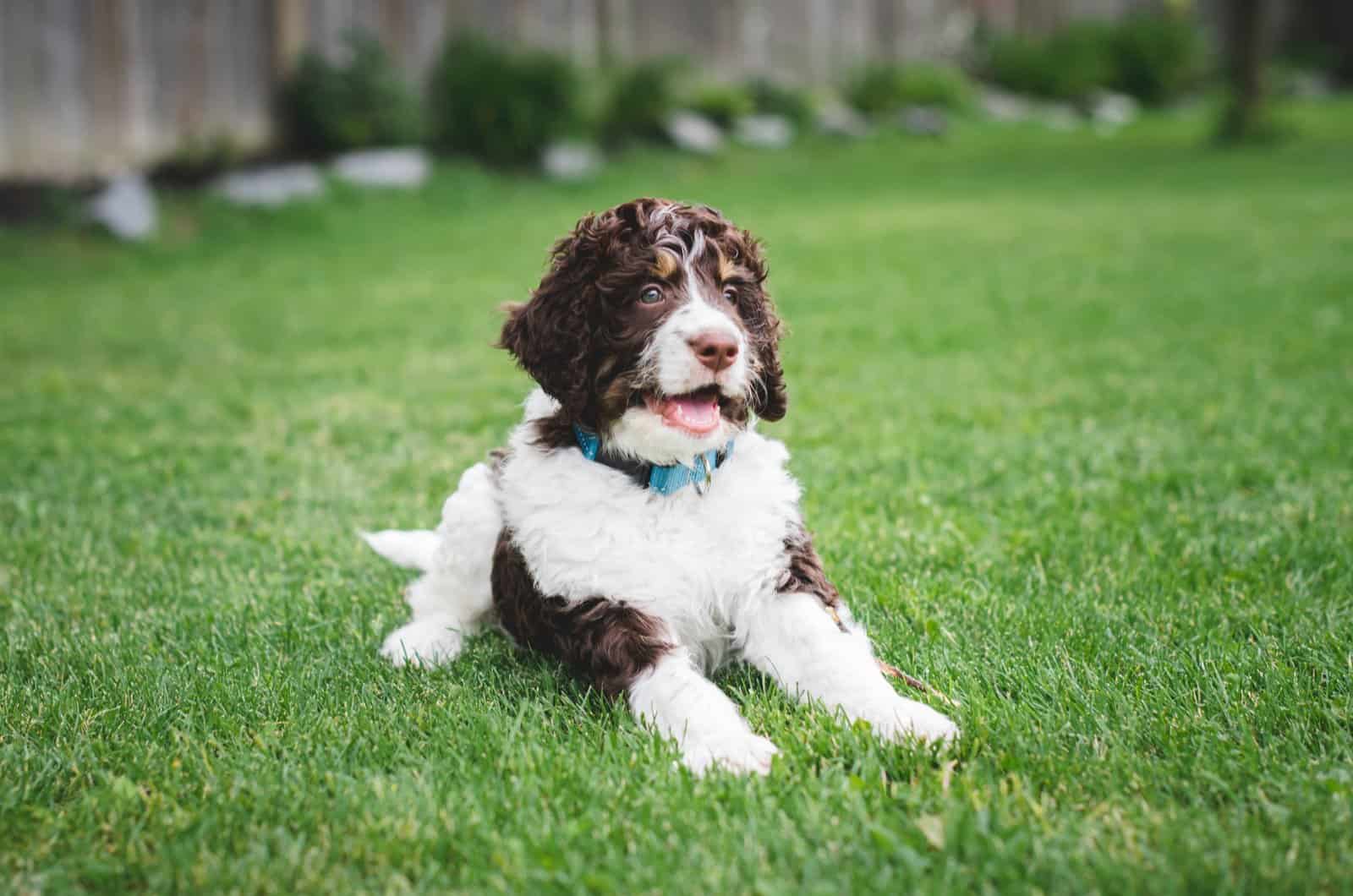
The Poodle is often praised as the most hypoallergenic dog, and that’s why it has been crossed with so many other dog breeds to produce a variety of allergy-friendly hybrid dogs.
We know about the Bernedoodle, but what other hypoallergenic Doodle breeds are there?
Here are a few Doodle-type dogs (Poodle mix) that might interest you. We’ve included the second breed in case it isn’t obvious from the name:
• Goldendoodles (Golden Retriever)
• Labradoodles (Labrador)
• Aussiedoodles (Australian Shepherd)
• Cockapoos (Cocker Spaniel)
• Schnoodle (Schnauzer)
• Cavapoo (Cavalier King Charles Spaniel)
• Maltipoo (Maltese Dog)
• Shih-Poo (Shih-Tzu)
• Yorkiepoo (Yorkshire Terrier)
Moving away from Doodles, there are many other hypoallergenic dog breeds to consider:
• Portuguese Water Dog
• Bichon Frise
• Chinese Crested
• Maltese Dog
• Irish Water Spaniel
• Shih-Tzu
• Basenji
• Yorkshire Terrier
• Soft Coated Wheaten Terrier
• Bedlington Terrier
• Schnauzer
• West Highland Terrier
• Havanese
• Lhasa Apso
You’ll have noticed that some dogs from the second list also appear in the first. If you pick one of these, you’ll be almost certain to have an allergy-friendly dog!
Tips On Reducing Allergy Symptoms
Hypoallergenic dog breeds are a great choice for mild to moderate allergy sufferers. Even so, there are measures you can take to reduce the risk further.
These tips might be helpful:
Invest in a good vacuum cleaner
A standard vacuum cleaner won’t do the trick. In fact, it will probably spread dust around and make the problem worse! You need a specially-designed pet hair model or at least one with a HEPA filter. These filters are fine enough to trap tiny particles, like dog dander.
It’s a good idea to vacuum your home thoroughly (including your sofas, if you allow your dogs on them!) two or three times a week to make sure you catch any hair and dander.
Install Laminate Flooring

Smooth, hard floors are easy to keep clean, whereas fabrics trap dirt and dust.
If at all practical, consider exchanging rugs and carpets for laminate floors. In fact, any smooth, continuous surface (like vinyl, polished concrete, or resin) will help. Exposing floorboards won’t really do the trick, as dust, hair, and dander will accumulate in the gaps between planks.
Regular Grooming
Daily brushing stops hair from falling about your home, as well as keeping your dog’s coat and skin in good condition.
Bathing your furry friend will help, but it’s not wise to wash them with shampoo more than once every three months.
Of course, if they get filthy and muddy, then it’s okay to wash them. However, bathing too frequently will strip out essential oils that keep the skin hydrated.
Without those oils, your dog’s skin will dry out and become flaky. This increases dander, which will add to your allergy woes.
You can find more advice about grooming further along.
Wash Pet Bedding Frequently
Keeping your dog’s bed and blankets clean gets rid of hair, saliva, and dander that sticks to them. Don’t use your normal laundry detergents that you wash your clothes in, as these contain toxins that are harmful to dogs.
There are several dog-friendly brands that are safe to use, so be sure to get one of these.
Make Areas Off Limits
Setting limits as to where your dog can go is a good idea, and your bedroom is a great place to start! While the idea of allowing your pooch to snuggle up to you or lie on the end of your bed while you sleep sounds cute, it could add to your allergy problems.
Your bed will be covered in hair, saliva, and dander that will inevitably make its way into your nose, eyes, and mouth.
If you can’t commit to keeping your furry friend out of the bedroom, at least consider making the bed itself off-limits.
The same applies to allowing dogs on sofas and armchairs.
Stop Kissing Your Dog!
Yes, we know, it’s harsh. But if you have allergies and you bury your face in that fur, then those allergens will be in your eyes, nose, and mouth within seconds.
Similarly, the risk is increased if your pet licks your hands and face.
Don’t worry; you can still show affection without risking a sneezing fit. You can fuss and pet your pooch as much as you wish, but just be sure to wash your hands regularly.
Invest In An Air Purifier
A good-quality air purifier will pull allergens from the air if left on constantly. Avoid all ‘ozone-generating’ purifiers, as these can worsen your symptoms. Ozone is an irritant that can trigger asthma attacks.
It’s a good idea to leave an air purifier running in your bedroom. Make sure you buy one with a HEPA filter, as these capture 99.95% of all allergy-causing particles.
Consult An Allergy Specialist
Although we’ve given a few tips here, it’s really only general advice. However, nothing beats the word of an expert on the subject! If you are concerned about your pet allergy, it’s best to see a trained medical professional.
They may offer the same advice we’ve mentioned here, but they are also qualified to prescribe medication (usually antihistamine) or suggest some natural remedies.
Hopefully, with all this advice, you can live relatively allergy-free with your furry friend! If you get a Bernedoodle (or any other hypoallergenic breed), you already have a good chance of reducing the possibility of being bugged by allergies. And by following these tips, you’ll cut the risk even further.
More About The Bernedoodle

Until now, we’ve focused mainly on the Bernedoodle’s coat and whether it’s good for people with allergies.
However, it would be a shame to only look at this single aspect and not take time to recognize this breed’s other qualities and see exactly what Bernedoodle owners can expect.
So, here’s a quick guide to the wonderful, quirky, unique, and kind-hearted Bernedoodle!
Bernedoodle Coat Colors And Appearance
As you might expect, they have a little of both breeds about them! If the puppy favors the Bernese Mountain Dog parent, they will be longer in the body and solidly built.
All Bernedoodles have a Poodle-like face, usually with the Berner’s long tongue hanging out! Their oval eyes are expressive and appealing, set wide on the head for maximum cuteness.
Their long ears drop down close against the side of their head, and overall these dogs have a general teddy bear look.
As for coat colors, you can find any of the following:
• Black
• Black and white
• Brown
• Black and brown
• White and brown
• Black, white and brown (tri-color)
• White
• Blue
• Fawn
• Black sable
• Merle
• Cream
• Gray
• Apricot
And there may well be others we’re not aware of!
If you have a specific color in mind, you should be aware that it’s not easy to predict puppy colors. Speak to your breeder and let them know what you would like, but there are no guarantees.
The most common colors are solid black, black and brown, black and white, or tri-color.
Bernedoodle Temperament
Thanks to the influence of the Bernese Mountain Dog parent, they tend to be pretty relaxed and calm. Don’t be fooled, though; they have plenty of energy when the need arises. If you enjoy hiking, your pooch will happily trot by your side, matching your every step.
If you prefer a more casual lifestyle, spending your free time reading or watching a movie, your Bernedoodle pup will be just as happy snoozing next to you.
These dogs are super-affectionate and loyal, forming incredibly strong bonds with their pet parents. They have a reputation as velcro-dogs and won’t easily forgive you for leaving them alone in the house.
Separation anxiety is a big issue for the Bernedoodle. It’s always best to avoid leaving them home alone for more than a couple of hours, four hours at the most. If this is unavoidable, try to arrange for visitors to drop by or use a dog sitting or dog walking service.
Because of their easy-going nature, these dogs are great with other dogs, cats, and all kinds of animals. Family pets should be safe from harm (but it’s always best to supervise!), and your pup will be the center of attention at the dog park.
Bernedoodles also love kids, especially younger ones. When raised together, they form a particularly strong bond that’s beautiful to see.
For all their goofiness and playfulness, they are very intelligent dogs! As with most smart canines, stubbornness can be an issue at times.
Training your Bernedoodle can be a challenge because of this at first, but they soon come around if you persevere.
Positive reinforcement is the best training method, particularly for a dog as sensitive as the Bernedoodle. Shouting and physical punishment are never acceptable, and dogs respond better to kindness and praise than they do to being smacked or hollered at.
Finally, these dogs are rarely aggressive, although they may display protective behavior if they feel that you or your home are being threatened. Early socialization helps your pooch to determine real threats from imagined ones.
And that’s the Bernedoodle!
Bernedoodle Grooming
Although they don’t shed as much as other dogs, they probably need more grooming than heavy-shedders! This is especially the case for Bernedoodles with curly coats.
With curly or wavy coats, matting can be a problem. Tangled and matted hair is painful for the dog as it pulls on the skin. If the skin breaks, it can become infected, so it’s important to keep the coat as tangle-free as possible.
As mentioned above, you should bathe your pooch pretty regularly, but not too frequently, especially with shampoo.
A quick spray down with clear, warm water will eliminate most dust and dirt from the surface, but when they need a ‘deep clean,’ it’s best to use a doggie shampoo and conditioner.
Don’t use human brands as these may contain harsh chemicals that will dry out their skin.
Clipping your dog’s hair is essential in keeping it healthy and under control. You can choose a cute style too! If you don’t feel confident enough to handle this, you could always use a professional groomer. Ideally, you should clip your puppy’s coat every six to eight weeks.
A good grooming regime includes clipping their toenails and checking their ears and teeth. Again, a groomer can help with those claws if you aren’t confident. Don’t feel bad about this: few dog owners like this task! It’s easy to cut too far and hurt your puppy.
You can invest in clippers with a guard that stops you from going too far or pay a professional groomer to do the job for you.
As for ears and teeth, they shouldn’t cause too many problems. Brush those fangs at least three times a week (more frequently, if possible) using dog-friendly toothpaste. Don’t use your own brand! Some contain a sweetener called xylitol which is highly toxic to dogs.
Bernedoodle Health Issues
As a mixed breed, the Bernedoodle generally enjoys better health than most purebred dogs. This is because of hybrid vigor, where the introduction of new genes prevents common genetic conditions from being passed on to the pups.
Even so, there’s a small risk that your Doodle dog may suffer from the following:
• Hip Dysplasia
• Elbow Dysplasia
• Skin allergies and hot spots
• Eye problems
• Cancer
• Epilepsy
The first two conditions are caused by poorly-formed joints that make bones grind against each other. As you can imagine, this is pretty painful! The joint becomes inflamed, and arthritis often follows at a later stage.
Mild cases can be managed with anti-inflammatories, although your vet will recommend surgery to fix the joint if the problem is severe. This process replaces the entire joint with a metal and plastic one that usually works better than the original one!
Skin allergies are pretty normal for dogs, usually due to food intolerance or environmental allergies. Interestingly, when dogs get skin allergies, it can increase the amount of dander they produce, which then aggravates human allergies!
A regular brushing and bathing routine will help reduce the risk. It’s also best to monitor their diet carefully to watch for any allergic reactions. Lactose intolerance is a big problem for dogs (technically, all dogs are lactose intolerant!) and may cause a reaction.
‘Hot spots’ are areas of inflamed skin caused by parasites, allergies, or infections. Dogs make them worse by scratching and biting at them.
They appear as raised red patches on the skin, and they can be sticky and wet, sometimes oozing fluids.
Known as ‘moist dermatitis,’ they often appear in warmer months, hence their other name of summer sores. Your vet will provide medication to treat these sores, and they should disappear pretty soon.
Poodles may pass on specific eye problems, like glaucoma and cataracts, which can usually be treated if not completely cured. However, PRA (progressive retinal atrophy) has no cure.
PRA includes several eye conditions that eventually cause blindness, and treatment is geared toward preparing the dog for life without sight.
Cancer is one of the most detested words in the English language. Dog owners dread it and hope they never hear their vet use this word concerning their pet.
Sadly, certain types of cancer are common in most dog breeds, including the Bernese Mountain Dog. Because of this, there’s a slight chance that the Bernedoodle will inherit this trait. However, the risk isn’t as great due to its mixed-breed status.
Finally, epilepsy can affect all dog breeds, usually due to sickness, trauma, or poisoning. If the cause isn’t known, this condition is called idiopathic epilepsy and is inherited from the parents.
Although this list of health conditions may seem alarming, the Bernedoodle is generally healthy and may avoid most, if not all, of these! You can help by getting your Bernedoodle from a reputable breeder, as they will perform health testing on the parent dogs.
This ensures that certain conditions aren’t passed on to the pups, and you’ll have a healthy, happy pup.
Exercising Your Bernedoodle
These dogs are highly adaptable and will slot easily into most lifestyles. They thrive in cold weather (because of their Berner heritage!) but can also cope with the summer heat.
Depending on its age and activity levels, your pup will need between thirty minutes and an hour of daily exercise.
They’re not the most active dogs going, but they enjoy a long walk. And they do love to play! These dogs take playtime seriously and will keep you laughing at their antics for hours.
Although they’ll fit into most home settings, it’s best to have a secure yard for your dog to play in. If not, you’ll need to take them out for walks more often.
As well as exercise, your furry pal requires mental stimulation. All dogs need this, but smart dogs are even more so.
Dogs need to keep their minds occupied, or they’ll get bored.
Boredom is not a good thing in smart dogs! They’ll fret and fuss and behave badly. That means your home and garden may get trashed, and you could get complaints from neighbors about the excessive barking.
Interactive puzzle toys are a great idea, especially those with treats inside. Your puppy will also love playing games, like find the chew toy, or a homemade obstacle course. You could even get them to work for their supper!
Dogs really like the idea of getting a reward for doing something. It provides a sense of achievement and is an excellent way of keeping them happy and providing mental stimulation.
The local dog park is an ideal way to stimulate your dog as bernedoodles are naturally sociable and love company. They’ll get a lot out of meeting the other dogs or even just catching up with all those exciting messages left in the scent marks around the place!
Bernedoodles learn tricks very quickly, and they love to perform them for you. Again, it’s all about getting a reward for doing well, and they can see how much it pleases you.
Conclusion: Are Bernedoodles Hypoallergenic?
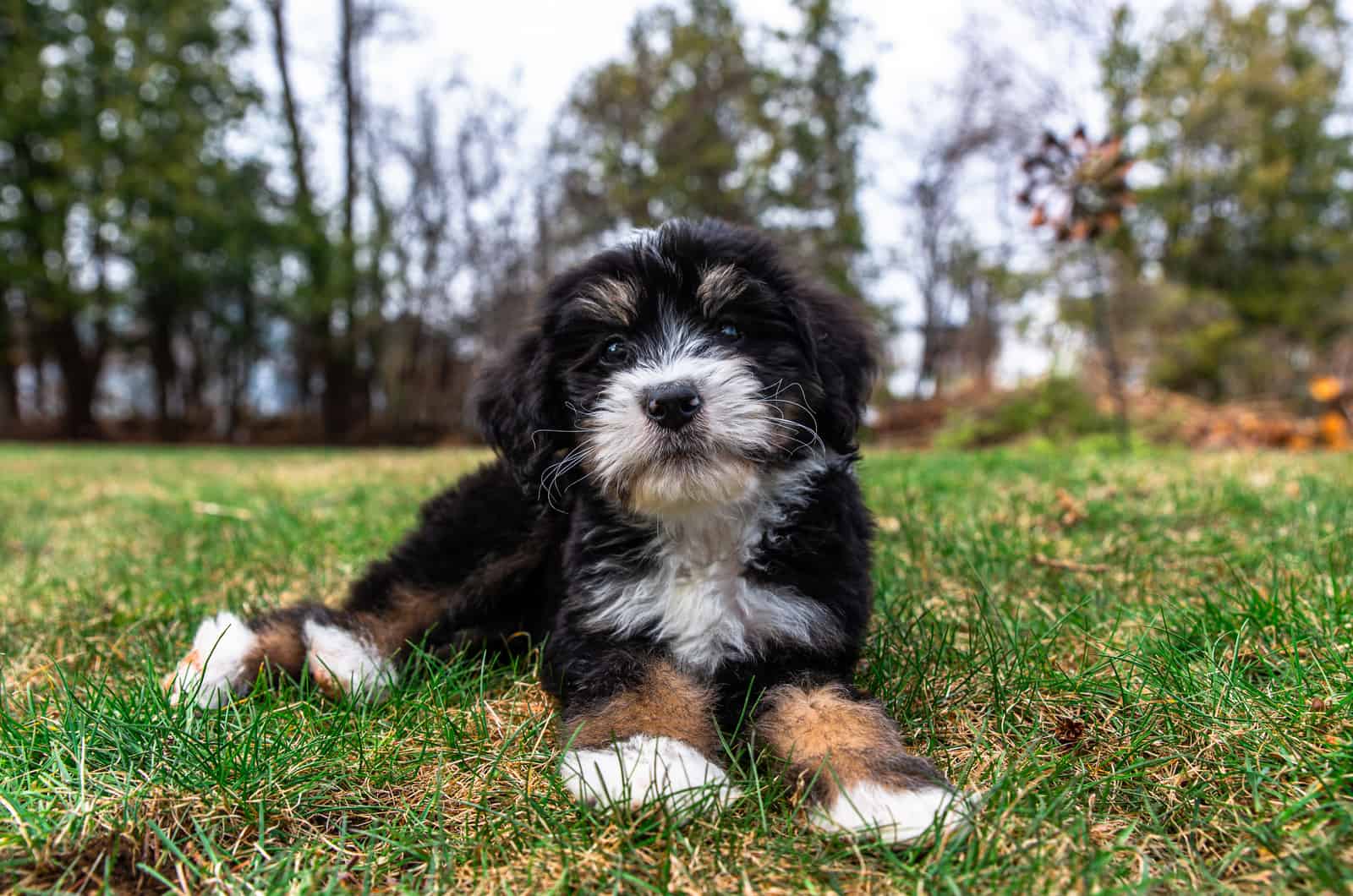
We’ve taken a deep dive into the Bernedoodle’s world to answer the question, Are Bernedoodles hypoallergenic?
As we discovered, the answer is that most of them are. However, we have to take into account that we’re all different and that some allergy sufferers will have an allergic reaction while others won’t.
It all comes down to how sensitive the individual’s immune system is. Only you know how bad the reaction can be. Some days it won’t show at all, while others can be really bad.
Even so, most people with mild pet allergies will be fine with Bernedoodles for most of the time, especially if they have the F1b dog.
We’ve also seen that there are several methods of reducing the risk of coming into contact with allergens in your home. Admittedly, some are easier than others, and a couple may be beyond your budget.
In the end, it depends on how badly you are likely to suffer and how much you want that puppy!
Some breeders offer an allergy testing service, where you can visit the kennel and meet one of their pups to see if you have a reaction. It’s not exactly scientific, but it could be helpful in testing whether the Bernedoodle triggers your allergy.
So, in summary, if you have a mild-to-moderate pet allergy, the Bernedoodle is an ideal choice as a family pet. It’s a loveable teddy bear dog that’s excellent with young kids and gets on with everyone, including pets, strangers, and other dogs.
The curlier its fur, the better, as it is like the famous allergy-friendly Poodle coat.
Although this dog is not as likely as other breeds to trigger an allergic reaction, it can never be ruled out entirely. You can help reduce the risk in several ways, such as using a HEPA filter vacuum cleaner and keeping your dog and your home as clean and tidy as possible.
There’s not much more to say except that if you can learn to manage your allergy, the Bernedoodle is the perfect choice!
Read Next: 12 Best Hypoallergenic Guard Dogs – No Sneezing On The Watch




